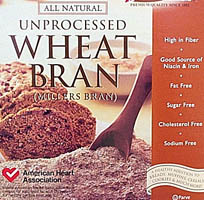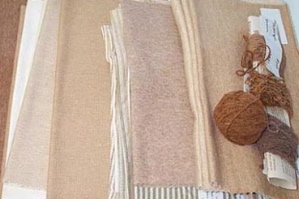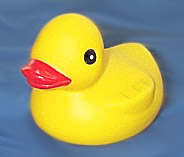
What do you think of when you hear the word FIBER??
Click on the picture below that fits the best.
And hey, you can click on the others too, just for fun!
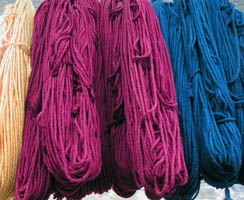
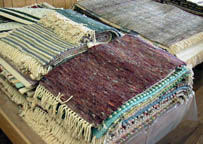
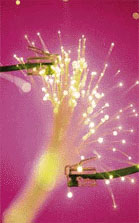
Fibers are like tiny little rods or tubes - much longer than they are wide.
Just about any fiber that you can think of is a polymer. (I guess that if it's a metal, it's called a wire, not a fiber!)
Fibers can be natural - from plant or animals, or synthetic - made by people.
Natural Fibers
When fibers come from plants, cellulose is the polymer made from the sugar glucose that makes those fibers strong. Natural fibers from plants include cotton, flax, jute, hemp, and sisal. Linen is a cloth made from flax, and has a rich history going all the way back to the ancient Egyptians.
Silk is made from the cocoons of silkworms. Unlike cellulose, it's a protein.
Wool is also a protein. Wool is the soft hair that's cut from animals like sheep, goats, llamas, alpacas, and even rabbits. Cashmere is extra-soft fur from goats. Angora rabbits give us angora fibers that are made into soft and fluffy sweaters and clothing. Mohair is wool from angora goats. Go figure!
Synthetic Fibers
A lot of different polymers can be made into fibers. Fibers are formed when polymer chains are all lined up in the same direction. That way, the chains can pack together tightly, kind of like this:

The chains don't have to be perfectly straight to form fibers, but the straighter they are, the easier it is to line up and pack together, and the stronger the fibers will be.
Polymers arranged in fibers like this can be spun into threads and used as textiles. The clothes you're wearing are made out of polymer fibers. So is carpet. So is rope.
Here are some polymers that can be made into fibers:
|
Polyethylene Polypropylene Polyester Nylon |
Kevlar and Nomex Polyacrylonitrile Polyurethanes |
Weird but true...
When polymer chains (or even atoms, molecules, and ions) are all lined up in a really orderly way, they become a crystal. Even sugar crystals (like rock candy) are little sugar molecules all packed together in a careful and ordered way.
Now, we said that the polymer chains have to be able to pack together in an ordered way so they can line up and be fibers. So -- fibers are always made of polymers that are arranged into crystals. In fact, fibers are really a kind of crystal, a really long and skinny kind of crystal. Wild, huh?
But wait, there's more!! Fibers can also have segments where the polymer chains are all jumbled up. Why could that be a good thing?
The ordered part of the fiber makes it strong and maybe even brittle. The jumbled-up part gives the fiber a place to bend and be flexible. These parts overlap to hold the fiber together. Crazy, but it works!
What would help to make the fibers even stronger?
If the ordered part, that is, the crystalline part, of the fiber makes it strong, what happens if we make some of the jumbled-up parts line up and be more like a crystal?
Nylon fibers get even stronger when they're stretched, or drawn out, when they're cool. The term for this is -you guessed it - "cold drawing."
What else could make fibers strong?
What if the chains were kind of sticky? That way, when the fibers are pulled, the chains wouldn't slide past each other very well.
We can show this by taking a closer look at the way nylon 6,6 packs to form a crystalline fiber.

The dotted lines between the H's and the O's are called hydrogen bonds. Pretend the H's and O's are little magnets that stick to each other, not holding hands, just kind of close and cozy and not wanting to be apart. When you pull on the fiber, those magnets won't want to let go. The fiber won't stretch very much, if at all. That's why fibers are good for rope and thread.
By the way, cellulose chains are stretched out and packed together with a whole bunch of hydrogen bonds between them - just like nylon! Even though the repeat units for cellulose and nylon are really different, they're alike in how the chains act. That's why cellulose is so strong too!
Fibers do have a down side. They're strong when you pull or stretch them, but they're weak when you try to squish or press them. Also, fibers are usually only strong in one direction, lengthwise. If you pull on them the other way, width-wise, they tend to be weak.

Working Together to Make Stronger Stuff
Because of this weird combination of weak and strong, it's often a good idea to mix fibers with another material, such as a thermoset. (A "thermo-set" is a polymer that sets, or gets hard, when it gets hot - that's the "thermo-" part.)
The fiber helps make the thermoset stronger, and the thermoset helps make the fiber stronger. Any mix of two or more materials is called a composite. When fibers are mixed in, it's called a "fiber-reinforced composite." They work together to be stronger!

|
Return to Making Stuff |

|
Return to Main Page |
